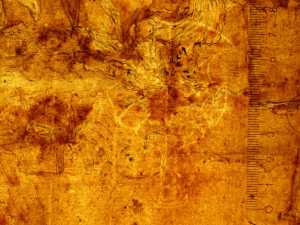Specificaties
| Titel | Thaegenes en Chariclea tussen gedode en gewonde piraten op de oever van de Nijlmonding ('Na de schipbreuk') |
|---|---|
| Materiaal en techniek | Zwart krijt, pen en penseel in bruine inkt, bruin gewassen, wit gehoogd, kaderlijnen met de pen in zwarte inkt (gedeeltelijk weggesneden) |
| Objectsoort |
Tekening
> Tweedimensionaal object
> Kunstvoorwerp
|
| Locatie | Dit object is in het depot |
| Afmetingen |
Hoogte 250 mm Breedte 293 mm |
|---|---|
| Makers |
Tekenaar:
Abraham Bloemaert
|
| Inventarisnummer | MB 1980/T 2 (PK) |
| Credits | Aankoop 1980 |
| Collectie | Tekeningen & Prenten |
| Verwervingsdatum | 1980 |
| Vervaardigingsdatum | in circa 1624-1625 |
| Signatuur | geen |
| Watermerk | coat of arms, unidentified (quartered: bend in 2 and 3, rampant lion in 1 and 4, but difficult to distinguish), initials BL in ligature beneath (75 x 58mm, on P4-5 from the left, right under the heads of the main characters; vH, 12P, fine, bifolio), the same type of watermark is present in a drawing by Jacob Matham in Museum Boijmans Van Beuningen, inv. JMat 2, and fragmented in one by Cornelis Claesz. Van Wieringen, inv. CCW 1): coat of arms (mirror image) of an unidentified family (Baden-Hochberg according to Briquet vol. 1, p. 89, but this family has another coat of arms)(quarterly: bend in 1 and 4, rampant lion in 2, half of an emerging lion on waves in 3), initials BL in ligature beneath, similar to Briquet 1075 (probably papermaker BL in Ettlingen, below Karlsruhe, county of Baden, Germany; doc. 1589-1601 but used well into the 17th c., a.o. doc. Utrecht 1589-1602, Leiden 1597; Briquet vol. I, p. 89)) and Heawood 602-604 (with other initials; doc. resp. Holland 1604, 1611, 1627) and 605 (without the bend but with the same initials BL in ligature; doc. Holland 1611). [AE] |
| Conditie | twee verticale vouwen in het midden, foxing, verkleuring ten gevolge van voormalig passepartout |
| Inscripties | geen |
| Merkteken | geen |
| Tentoonstellingen | Utrecht/Schwerin 2011, nr. 50 |
| Externe tentoonstellingen |
Abraham Bloemaert. Een grootheid uit de Gouden Eeuw (2011) Abraham Bloemaert - Een grootheid uit de Gouden Eeuw (2012) |
| Onderzoek |
Toon onderzoek Nederlandse tekeningen uit de vijftiende en zestiende eeuw |
| Literatuur | The Hague 1997-1998, pp. 104-105, fig. 2; Plomp 2001, p. 202, nr. 20; Bolten 2007, nr. 554; Elen 2011, pp. 32-37, fig. 16; Collection Catalogue 2012 (online) |
| Materiaal | |
| Object | |
| Techniek |
Gehoogd
> Schildertechniek
> Techniek
> Materiaal en techniek
Bruin gewassen
> Wassen
> Gewassen
> Tekentechniek
> Techniek
> Materiaal en techniek
|
| Geografische herkomst | Nederland > West-Europa > Europa |


























